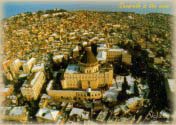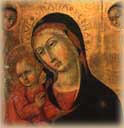|
|
|
Nazareth 2000
Nazareth is not included among the 45 cities of the Galilee that were mentioned by Joseph's, and It's name is missing from the 63 towns in Galilee mentioned in the Talmud.
It seems that the words of Nathanel of Cana, "Can anything good come out of Nazareth?" (John 1:47) characterized the site's seeming insignificance.
It is needless to say that the people of Judea had never heard of Nazareth - from this we understand the reason that Pontius Pilate decorates the cross with the sign "Jesus of Nazareth, King of the Jews" (John 19:19) - meaning that the "King of the Jews" is from "nowhere."
The early name "Nazarenes" given to the Christians might have been a derogatory nickname that the people of Judea gave to the followers of Jesus (Matthew 26:71, Acts 6:38).
Jesus was known throughout the Galilee as "Jesus of Nazareth" (Matthew 21:1 1, Mark 14:67) - but for those not from the Galilee, this name had no meaning for them.
In order to explain where Nazareth was located, the Galileans had to explain that the village was near Gat-Hyefer (Jonah's hometown, Kings 11 14:25), which could be seen from Nazareth.
Archaeological excavations conducted in Nazareth (by Bagati since
1955) show that Nazareth was a small
agricultural village settled by a few dozen families.
The pottery remains testify to a continuous settlement during the
period 600-900 BC. After those years, there was a break in settlement until
the year 200 BC. Since then, the site of Nazareth has been consistently
inhabited.
Most of the archaeological finds consist of caves,
cisterns and grain storage bins.
The agricultural character of the site is made obvious with the discoveries of oil mills and mill stones - There were a large number of underground rooms because the soft chalk of Nazareth made it easy to hew caves.

The valley of Jezreel, as it is seen from Nazareth, is a natural battlefield. This fact must have influenced the idea of "all the holders of swords shall fall by the sword," (Matthew 28:52).
Another geographical area adjacent to Nazareth was the lower Galilee and the Beti Netofa valley.
In this region there were many small Jewish villages and towns settled by Hellenized Syrians. The largest of these towns was Tzippori, the capital of the Galilee until the year IS BC. Even though Tzippori is a 45 minute - walk from Nazareth, the town is not mentioned in the New Testament.
The main events in Jesus's life, as described in the New Testament, are the annunciation of his birth (Luke 1: 26-3 8), his childhood and early manhood (Luke 2:39-52, Matthew 2:19-23), and the clash with his fellow citizens (Matthew 13:5458, Luke 4:17-30).

To them he was Jesus, one of the sons of Joseph the carpenter (the other brothers were James, Joseph, Simeon and Judah Matthew 13:55).
Luke describes with great drama how Jesus was rejected by the people of Nazareth.
After his sermon in the synagogue aroused their anger, the people
took him "and brought him to the precipice of the mountain that their city
was built upon" (Luke 4). Some have pointed out that this sentence in Luke
is not correct, as Nazareth is built in a valley and not on a mountain.
But the valley of Nazareth is on a mountain overlooking the Jezreel
valley and the mountain of the precipice overlooks the valley of Nazareth
and the valley of Jezreel.
Nazareth is also holy to Christians because it throws light on the
holy family, especially Mary, the mother of Jesus.
This is the place where a Christian believer can consider Mary's
qualities, Her character as a noble woman, a woman of purity, simplicity,
sensitivity and pureness of heart.
Mary is portrayed as a mother who devotes herself to the education of her son and remains devoted to him in the most tiring of circumstances (she was present at his crucifixion - John 19:25 - and recognized him as the messiah - Acts 2:36).
For Catholics, Mary has a special significance - and her special place in the New Testament is hinted at in the verses "Blessed art though of women" (Luke 1:41) and "Peace unto thee woman of grace, God be with you" (Luke 1:28).
Sites In Nazareth
*The Church of Saint Gabriel
* The nearby Church of Saint Joseph * At the top of the
slope
* The bishop's residence * The Mosque
Quarter * Casa Nova Street
Programs PEACE TOUR 8 Days / 7Nights 7 Days /6 Nights 4 Days / 3Nights 5 Days / 4 Nights
![]()